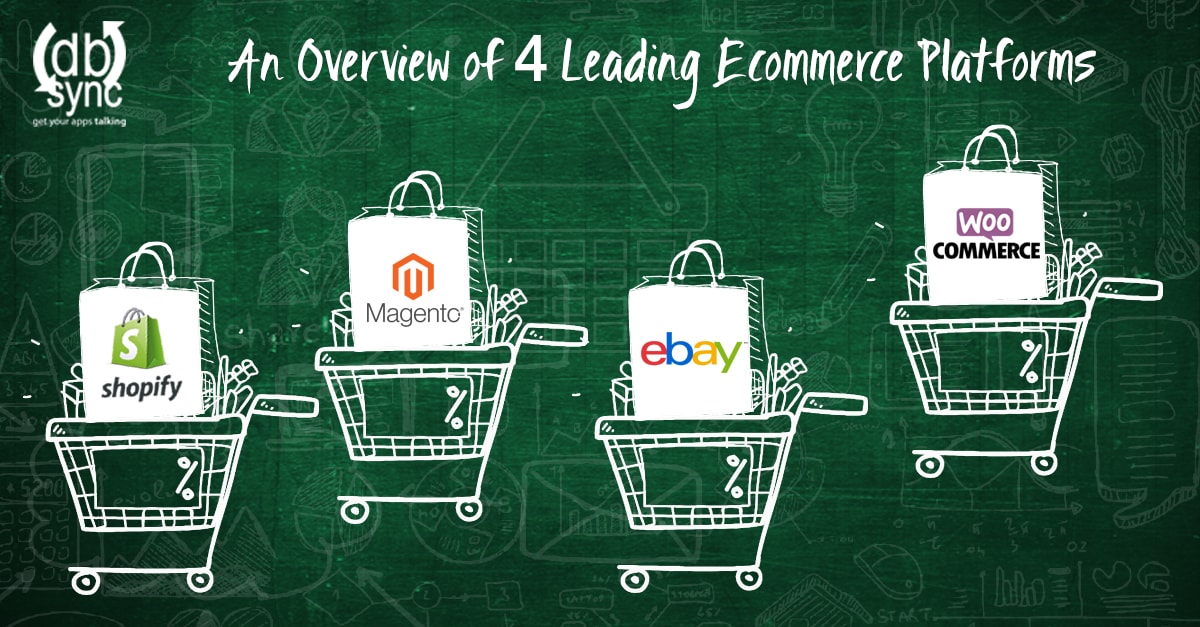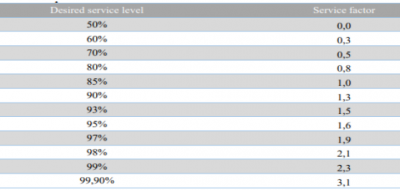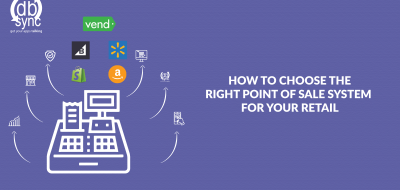Need a platform for your online business? From small stores to mega shops, ecommerce platforms provide a strong and consistent technology, which today, is an integral part of many businesses.
Although there are many options available on the market, there are some classic names that have become predominant.
This article examines four of them, namely Shopify, Magento, eBay and WooCommerce. Filled with details on the positives and negatives of each of them, and featuring instructions on how to choose your optimal ecommerce platform, it teaches you all the core basics that you need for your selection.
Shopify
Shopify is an e-commerce platform for online stores. Created in 2006, it has become one of the most popular options for online merchants.
Key facts
- Website: https://www.shopify.com
- First release date: 2006
- Latest release date: Continuous/SAAS
- Latest stable version: Continuous/SAAS
- Language: Ruby
Pros
Shopify stands out for its intuitive interface, which is clearly great for the non-technical user. This fact is very important when you think about the design of an online store that caters for your needs perfectly.
Added to the friendly interface is the automatic optimization for screens of different sizes. Considering that mobile shoppers numbers are constantly increasing, having a proper access to them is a very important plus.
In addition, as it is a self-hosting solution, you don’t have to worry about the technicalities of web management.
If you have any questions, a 24/7 help line, live chat and e-mail support are available. No matter how small or big your problem is, you know there is someone there to help you.
Furthermore, you can become part of its online community, available through a forum, which has a very active audience.
Summarizing, if you just want to concentrate on what you know better: your business, and forget about technical problems, Shopify is a great choice.
Integration
Regarding integration, Shopify presents a set of APIs that help you build other apps and integrations. The APIs are very powerful and diverse, covering every stage of a store’s operation. For example, you can create a web page as a storefront, which is powered by Shopify. For information on the different choices, go to here.
And what is also great, it is the availability of software connectors, such as DBSync’s, which lets you integrate the platform with other systems such as Quickbooks or databases such as MySQL.
There are several use cases for using an Integration platform or an iPaaS with Shopify. Does your shopify business need iPaaS ?
Cons
The main con with Shopify is that you have to pay for the service. This can be a problem, particularly at the beginning when your sales are slow.

Figure 1: The Economist uses Shopify for its online items’ sale
Magento
Magento is an e-commerce platform. Owned by Permira Private Equity, it will be acquired this year by Adobe System Inc. It comes in two flavors: open source and commercial. Here we will analyze the open source platform.
Key facts
- Website: https://www.magento.com
- First release date: 13th August 2007
- Latest release date: 2nd May 2018
- Latest stable version: 2.2.4
- Language: PHP
Pros
The community edition is open source, meaning that it is available to you for free.
It is a very flexible platform, which gives you many options when designing your store. With Magento you can really make your store original and standing out from others, if you have the right programming skills.
These options will probably increase in number if the platform is acquired by Adobe, because it will add the power of using some potent content systems.
Additionally, Magento has a strong community support, meaning that if you run into problems there is a lot of free help available out there. If you are willing to pay, you can also find Magento certified consultants.
Integration
Regarding integration, Magento presents some powerful tools in the form of REST APIs. These APIs allow third-party services to connect to the app. The Magento APIs currently supports Accounting, Enterprise Resource Planning (ERP), Customer Relationship Management (CRM), Product Information Management (PIM), and marketing automation. A good source of information can be found at here and here.
Cons
The main drawback with Magento community edition is that it demands technical knowledge from you. From its installation to the creation and maintenance of your online store, you will need familiarity with many technical concepts. Besides, if you want to benefit from its full functionality, you will need some coding from your side.
This implies that you will have to invest in time to study it, or, alternatively, you will have to hire the necessary people, with all its costs implications.
Moreover, you will have to provide your own hosting, which means additional costs.

Figure 2: Samsclub.com uses Magento Open Source for its auctions platform
eBay
eBay is an online shopping platform that facilitates the interaction between clients and between clients and business. It operates in about 30 countries.
Key facts
- Website: https://www.ebay.com/
- First release date: 1995
- Latest release date: Continuous
- Latest stable version: Continuous
Pros
“People don’t know where to find stuff” explained Mark Cumming, CEO and co-founder of Pointy, a Dublin based technical company advising Google.
It is here that eBay’s major advantage stands out: its high traffic volume, which translates into the fact that you don’t need to attract clients by yourself, as there is a huge amount of buyers searching for items similar to yours on eBay.
Adding to it, eBay simplifies searches by classifying items according to categories such as motors, fashion, electronics and many more.
In addition, fees are charged per item with the first few ones for free. Thus, eBay can be the optimal choice when you are thinking about selling a few things only.
Integration
When it comes to integration, eBay is a champion. It offers a wide and powerful set of APIs that help you to create end-to-end selling applications. The APIs cover Account, Inventory, Compliance, Marketing, Analytics and many more. Check out some useful information.
Cons
You will find it difficult to build a customer-brand relationship, as you are selling each item independently. Remember, you are selling in a marketplace, not in a store.
Besides, as you are charged a per item fee, when considering selling many items and in a continuous manner, this fact can amount to substantial costs.

Figure 3 – eBay allows you to sell items by category.
WooCommerce
WooCommerce is a plugin for WordPress. It basically operates on the freemium model. The plugin is for free, with many add-ons available. Some of these add-ons are paid for, some are for free.
Key facts
- Website: https://woocommerce.com/
- First release date: June 2003
- Latest release date: 31st December 2017
- Latest stable version: 3.0.7
- Language: PHP
Pros
The very main advantage of WooCommerce is that it is open source, which means that you have it for free. The second one, is that it is part of a bigger name called WordPress.
The product is famed for its simplicity to install and customize. In addition, by being part of WordPress, it provides you with the rich selections of themes and tools already being used by many content developers.
WooCommerce is used by many high-traffic businesses, such as Small Press Expo. It presents some noteworthy add-ins, such as Bookings, which allows you to sell time appointments; and Membership, which lets you restrict the access to certain parts of your website to selected clients.
Integration
As it is part of WordPress, WooCommerce can be integrated to other apps via plugins. A good source of information on how to do this is available here.
Cons
As mentioned earlier to you, the main constraint of this framework is that it needs a WordPress website, which also means you have to pay a hosting fee.
Also, by default, WooCommerce cannot deliver invoices and it is limited in the amount of payment types available. You will have to use some plug-ins to solve these problems.
However, not all available plug-ins are for free, adding a new cost if you need a paid one.

Figure 4 – Ripley’s Believe It or Not Bookstore uses WooCommerce for its online book sales.
Summary table

How to choose.
When choosing an online selling platform, you are really making a decision between different business models. So the answer depends on what you really want to do.
Your first question should be: do I want an online store or do I just need to sell items?
If you decide to simply sell items, eBay can be a good option, as you don’t need to attract customers: they go to eBay searching for a product similar to yours.
eBay can also be an option when getting started: while you build your brand through an online store, you can also use eBay to earn some money in the short term.
If your choice is an online store, then your next question should be: am I prepared to consider a learning period or I want a platform that lets me start almost immediately?
If you want to start without delay, Shopify is an option to consider. Although, you have to pay for the service, your online store can be ready promptly. In addition, you don’t have to worry about hosting technicalities. Your focus is selling, not IT worrying.
If you prefer a free option, then your choice is between Magento and WooCommerce. Your next question is this: do I have a WordPress site? If the answer is yes, then WooCommerce can be your route.
Finally, if you don’t have much capital, you can gather some deep technical knowledge and you can spend time setting the right store for you, Magento is a framework that is well known in the market and can solve your problems.
Summarizing
You have learnt about the pros and cons of four different online selling platforms. None of them is the best. Each has its benefits and problems. Choosing the right one for you depends on your business model.







